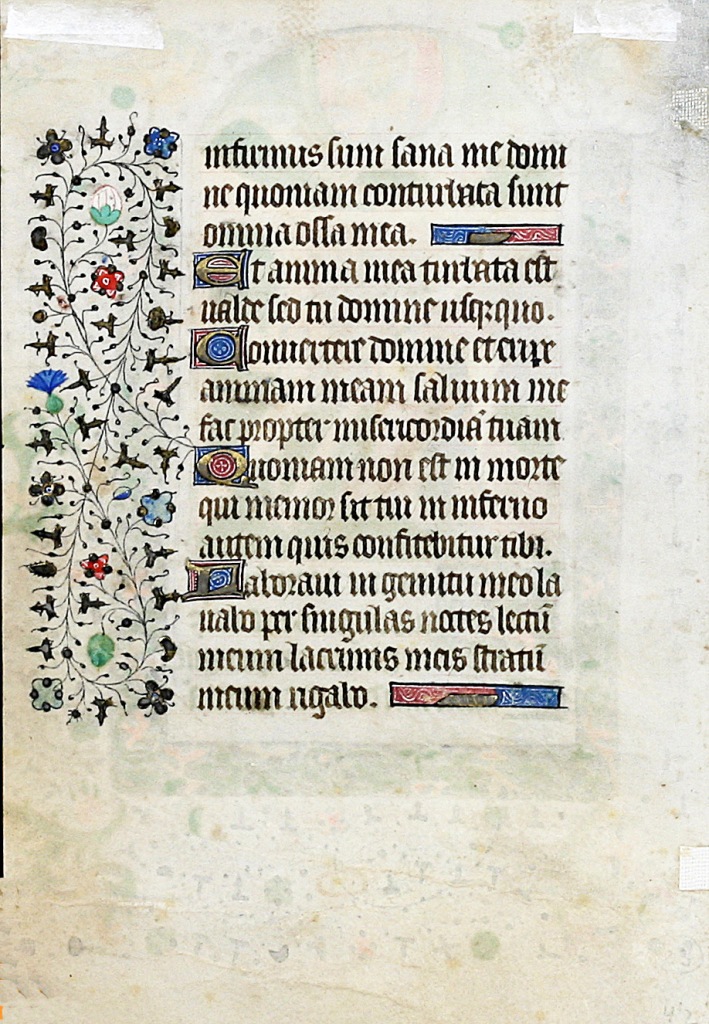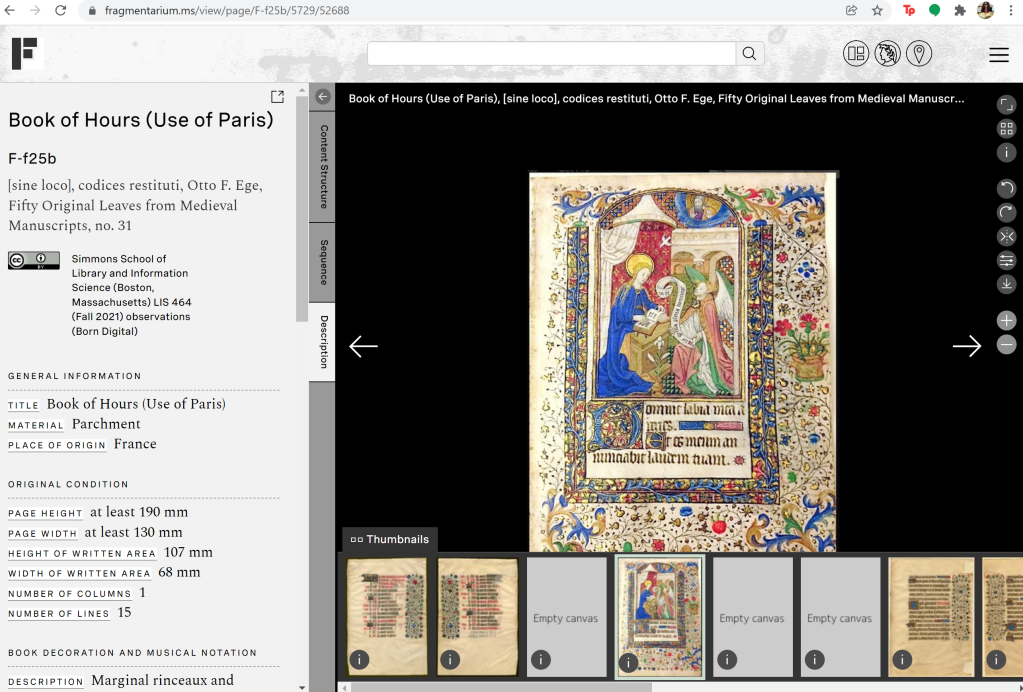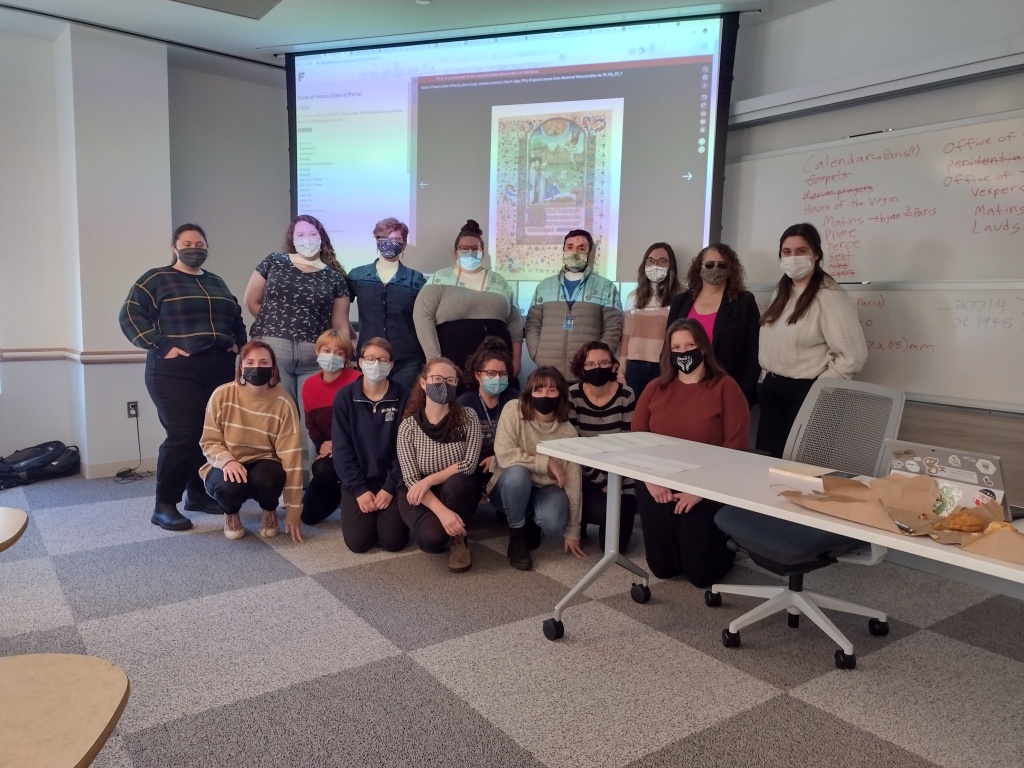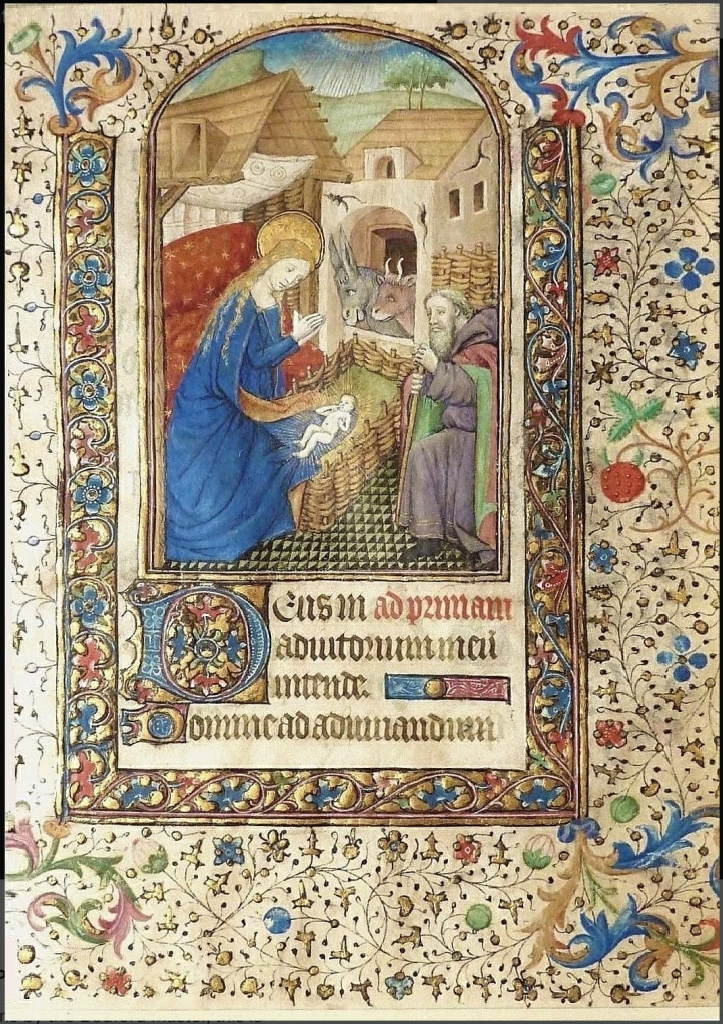It’s been a rough few years, friends. We have all been through so much during the pandemic, and for students and teachers the pivots and policies have been particularly difficult and frustrating. Trying to stay safe, learning to teach online, dealing with trauma and loss, getting used to social-distanced and masked pedagogy, in addition to the usual pressures of teaching and learning. It was a particular delight, then, to see my extraordinary Simmons University School of Library Science students here in Boston make their way through this semester’s course “The Medieval Manuscript from Charlemagne to Gutenberg” not only with resilience and steadfastness, but with enthusiasm, intellectual curiosity, and the joy of discovery.
As always, the final project for my class this semester was a digital reconstruction of one of the Books of Hours dismembered by Otto Ege in the first half of the twentieth century. This year, we chose the lovely ca. 1430 Book of Hours from France whose leaves became no. 31 in the Ege portfolio, “Fifty Original Leaves from Medieval Manuscripts.” Each of my fourteen students was assigned one leaf from one of the known portfolios (such as the leaf at Stony Brook University, shown at right) to research and catalogue. They had to use online resources such as the Hypertext Book of Hours to identify the text on their leaf, and then catalogue the leaf using the Fragmentarium database. Some of the students were so enthusiastic about the project that they catalogued more than the one leaf originally assigned to them. I did some as well, so that we could work with as many leaves as possible.
One of my students took extraordinary initiative and spent hours searching the internet to try to find more leaves. She found several, including a calendar page at Dartmouth College and a miniature that was recently sold by the Manhattan Rare Book Company. Both of these are rare and important finds for an Ege manuscript. Generally, it is very difficult to definitively identify miniatures from the Ege manuscripts, since they were sold separately from the text leaves that are found in portfolios and often are framed so that the text side is not visible, making it quite difficult to determine if the miniature came from the target manuscript. In this case, however, the bookseller had reproduced the text side as well, so we could tell for sure that this miniature was from our manuscript. The miniature (below) was a depiction of King David at prayer, the opening of the Penitential Psalms section of the Book of Hours. The gold ring surrounding the vines in the lower margin is a motif that appears in other leaves, and may suggest that the book was commissioned to commemorate a marriage.


I wrote to the bookseller to ask for more information, and he informed me that the miniature had just been sold to a private collector in New York City. He contacted the owner on my behalf, and the new owner emailed me directly to let me know that he in fact owned THREE miniatures from this manuscript! In addition to David at Prayer, he had acquired miniatures of the Annunciation (Matins, Hours of the Virgin) and the Nativity (Prime, Hours of the Virgin).


In the meantime, following the trail left by Scott Gwara in his entry for this manuscript from his monograph, Otto Ege’s Manuscripts ((Cayce, SC : De Brailes Publishing, 2013), pp. 128-129), the same student tracked down a copy of Judith Oliver’s catalogue of a now-defunct collection formerly belonging to the Boston University School of Theology, where four miniatures, including the Annunciation and the Nativity, were illustrated.

Gwara recorded a miniature as well, this burial scene belonging to the Memphis Brooks Museum of Art that was purchased from Ege’s widow Louise in 1956. Now we had SIX miniatures to work with, two of which are untraced (the Annunciation to the Shepherds and the Adoration of the Magi, shown at right above). There are almost certainly several more miniatures that have not been located, completing the series for the Hours of the Virgin (the Visitation, the Presentation, the Flight into Egypt, and the Coronation of Virgin). There may also have been one or more miniatures illustrating the Gospel Readings that would have followed the calendar. With so much evidence, an art-historical analysis was possible. A group of students worked together to craft this stylistic description:
“Marginal rinceaux and painted line fillers, smallish acanthus leaves on miniature pages only. Margins also include gold trefoil and red, blue, and green flowers growing on the rinceaux. Rinceaux often seems to “sprout” out of the text, usually from a single gold initial or line-filler. Borders on recto and verso are mirrored for efficiency. Some leaves show a gold ring motif among the rinceaux. Miniatures with gold U-borders with flowers/ leaves in red and blue. Continental color palette: Blues, purples, jewel tone & continental design: botanical, leafy, organic. Miniature composition similar to Bedford Master Workshop (see Oliver, pp. 58-59), Dunois Master Workshop, and occasionally elements of Boucicaut Master Workshop (as suggested by Sotheby’s).”
[it is important to note that of the five other non-portfolio leaves identified by Gwara as coming from this manuscript, upon inspection only the Memphis leaf could be affiliated with Ege 31; the other four are from a different manuscript entirely]
In the end, we identified a total of thirty-seven leaves of this manuscript. After each student had catalogued their leaf/leaves in Fragmentarium, we then worked together in class to use Fragmentarium’s IIIF-sequencing functionality to digitally recreate the manuscript:

While some students were scouring the internet for additional leaves, others were conducting codicological research. One student selected two leaves at random to catalogue – from Massey College at the University of Toronto and the Wadsworth Athenaeum in Hartford, Connecticut – that turned out to be consecutive. Several other students identified formerly-consecutive leaves, and we even found eight leaves in a row. These consecutive runs, combined with evidence such as surviving catchwords on several leaves, allowed us to partially reconstruct several quires (using an innovative and intuitive resource called VisColl). In those three quires, we identified four pairs of formerly-conjoint bifolia, highlighted in green above. Yale University’s Beinecke Library preserves a still-conjoint consecutive bifolium from the manuscript in its portfolio. Other pairs were reconstructed using textual and codicological evidence. The catchword on the verso of the leaf at Harvard University’s Houghton Library, for example (below left), indicates that this bifolium was the outermost of its quire (L9/L16 in the diagram above). In other words, each of these pairs of leaves were once attached to one another at the gutter as a single sheet of parchment, folded in half and sewn into the quire. When Ege dismembered the manuscript, he disbound the quires and split the conjoints. These pairs of leaves haven’t seen each other in nearly a century. Below, the leaf at Harvard University’s Houghton Library is virtually reunited with its former conjoint, now at the University of Saskatchewan, nearly 2,300 miles away.


We have analyzed art historical evidence and codicological evidence. What about the contents? The surviving leaves preserve portions of several sections of the manuscript: the Calendar, Hours of the Virgin, Hours of the Cross, Penitential Psalms, and the Office of the Dead. While we did not recover the critical pieces of liturgy that are usually used to determine Use (the antiphon and chapter reading for Prime and None of the Hours of the Virgin, as well as the Matins Responsories of the Office of the Dead), independent research by several students helped identify the origins of the manuscript. One student determined that the particular hymn used on the page she had been assigned seemed to indicate that the manuscript was for the Use of Paris. Another found that an atypical Psalm used at Vespers for the Office of Dead was also suggestive of Use of Paris. The few Matins responsories recovered for the Office of the Dead were consistent with Paris Use and, after a careful in-class analysis of the saints named on the calendar page, we felt we could confidently identify this manuscript as made for the Use of Paris.
That’s as far as we’ve gone so far. We spent several hours conducting provenance research in the Schoenberg Database of Manuscripts, trying to identify any pre-Ege sales of this manuscript (with help from provenance-researcher-extraordinaire Laura Cleaver and the always-helpful reference librarians at The Grolier Club Library), but we haven’t found it yet. The dimensions of the manuscript (190 x 160 (107 x 68) mm) are fairly typical, as is the number of lines (15), making it difficult to definitively identify this manuscript in an early sales record.

The semester is over, but the work continues. The linked-open data model and interoperable image sequencing reflect best digital practices. This means that if more leaves are identified, they can easily be added to the reconstruction, and if I ever do manage to find a sales record that seems to represent this manuscript when it was whole, I can update the Fragmentarium record accordingly.
This annual project accomplishes many of my goals for my students, all of whom are pursuing a Masters of Library Science: craft clean, consistent, linked data; work with digital images in a IIIF environment; analyze paleographical, art historical, and codicological evidence to determine the date and place of origin of a medieval manuscript; understand how to research and work with Books of Hours, which are among the most common genres of medieval manuscripts in North American collections; and work collaboratively. Each student’s record has its own persistent and citable URL, as does the reconstruction. The work of previous years can be found here, and for more information about other scholars who are doing reconstructions and studies of other Ege manuscripts, see this blogpost.
I hope to take on another reconstruction with Simmons students next fall, hopefully in a post-pandemic world. In the meantime, I wish you a very Merry Christmas and a Happy, and Healthy, New Year.













